Ambrette seeds are your secret weapon for anchoring natural perfumes, thanks to their powerful fixing abilities and complex musky profile. When you use these seeds as a base note, they'll stabilize volatile components for up to 400 hours while adding warmth and sophistication to your blend. Start with just 0.2% of your total formula, combining them with florals like rose or woods like sandalwood. The natural musk marvel's full potential goes far deeper than its initial impression suggests.
The Natural Musk Marvel: Understanding Ambrette Seeds
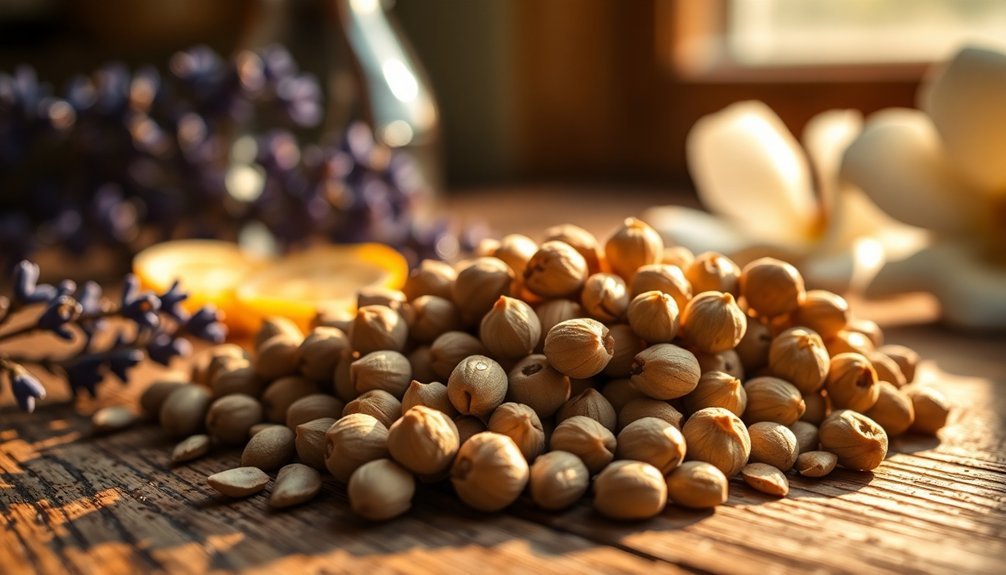
A natural perfumer's treasure, ambrette seeds offer a remarkable alternative to traditional animal-derived musks.
You'll discover their complex scent profile combines musky and ambery notes with surprising hints of pear, plum, and iris. The seeds' signature molecule, ambrettolide, creates a powdery, sensual aroma that's remarkably close to natural musk.
What makes ambrette truly special is its versatility as a base note that can peek through even in top notes, thanks to its vibrant character. With production reaching 60 tons annually, these precious seeds remain a cornerstone of natural perfumery.
You'll notice it evokes the comforting scent of warm, clean skin while delivering subtle undertones of toasted nuts.
When you're crafting natural perfumes, you'll find ambrette seeds blend seamlessly with all olfactory families, from bright citruses to deep orientals, making them an invaluable ingredient in your perfumery palette.
Origins and Botanical Heritage of the Musk Mallow
While many aromatic plants have enthralling histories, the musk mallow (Abelmoschus moschatus Medik) stands out as a remarkable member of the Malvaceae family.
You'll find this tropical shrub thriving in its native India and across the lush forests of Asia, Indonesia, Peru, and the West Indies. As a cousin to the hibiscus, it's grown into a valuable botanical treasure in both natural perfumery and traditional practices. The seeds of this plant produce sublime musky notes that have made them highly sought after in the fragrance industry.
- Grows up to 3.5 meters tall, producing stunning sulphur yellow flowers with distinctive brown throats
- Develops large seed pods that transform from green to brown, housing precious kidney-shaped seeds
- Flourishes in biodiversity-rich forest ecosystems and agroforestry settings, particularly north of Guayaquil and in San Martín, Peru
Breaking Down the Complex Scent Profile

When you encounter ambrette seeds in natural perfumes, you'll notice their remarkably complex scent unfolds in waves of sweet musk intertwined with fruity lychee-like notes.
The heart reveals rich cognac and tobacco undertones, creating an intoxicating blend that shifts into leathery, animalic facets. The pale yellow liquid adds subtle warmth to compositions while maintaining its sophisticated character.
These multi-layered aromatics make ambrette seeds a fascinating natural ingredient, as they deliver both the bright, sweet characteristics of top notes and the deep, tenacious qualities of base notes.
Multi-Layered Aromatics Present
Diving deep into ambrette seed's scent profile reveals a sophisticated tapestry of intertwining aromatics.
You'll discover a powerful musky foundation that's both rich and tenacious, setting the stage for multiple layers of complementary notes.
- A complex musky base with sweet and warm undertones that provide lasting power
- Delicate floral accords of acacia and cassie, balanced with subtle fruity nuances
- Distinctive nutty and woody elements that add depth and earthiness
When you experience ambrette seed's aroma, you'll notice how these layers work together harmoniously.
The intense musk serves as an anchor while floral and fruity notes add elegance.
Meanwhile, the nutty and woody characteristics create a robust foundation.
This multi-faceted profile makes ambrette seed incredibly versatile in natural perfumery, where it enhances and stabilizes other fragrance elements.
Sweet Musk Meets Fruit
At the heart of ambrette seed's complexity lies a fascinating interplay between sweet musk and fruit notes. You'll discover a warm, skin-like muskiness that blends seamlessly with hints of overripe lychee and subtle floral undertones. This natural musk substitute offers you a more refined alternative to synthetic musks, with its powerful yet nuanced character.
| Musk Aspects | Fruit & Floral Notes |
|---|---|
| Clean, warm skin | Overripe lychee |
| Sensual depth | Orange blossom |
| Powerful base | Rose complement |
| Natural musk | Jasmine accent |
| Tenacious presence | Subtle floralcy |
When you're working with ambrette in natural perfumery, you'll notice how it transforms on your skin, creating a rich foundation that supports both fruity and floral elements. Its wine-like qualities and nutty nuances add unexpected dimensions to your fragrances.
Leather and Tobacco Notes
The sophisticated marriage of leather and tobacco notes in ambrette seeds creates a rich, multifaceted fragrance profile that's both distinctive and refined.
You'll discover that tobacco leaves undergo careful drying and fermentation processes to preserve their natural essence, while their complex olfactory nuances blend seamlessly with leather accords. This combination often appears in premium fragrances, where you'll find them anchored by ambrette's unique characteristics.
- Warm spices and bergamot enhance the top notes, creating an immediate sophistication
- Base notes of amber, vetiver, and patchouli provide depth and lasting power
- Sun-cured tobacco and fermented leaf extracts add rich, woody undertones
The result is an enchanting blend that's particularly evident in masculine fragrances, where ambrette seeds help harmonize these bold, assertive notes into a cohesive composition.
The Science Behind Ambrette's Fixing Power
When perfumers seek natural fixatives for their fragrances, ambrette seeds stand out as a powerhouse of molecular stability. The secret lies in ambrettolide, a compound that can last over 400 hours on a smelling strip, making it one of the most powerful musks in modern perfumery.
You'll find that ambrette's fixing power comes from its complex chemical composition. Ambrettolide works alongside isoambrettolide and farnesol to create a stable base that anchors other fragrance notes.
When you combine these compounds with palmitic acid, you get a natural fixative that not only extends your perfume's life but also enhances its overall character. This molecular structure helps stabilize volatile components in your fragrance while adding depth through its musky, floral, and woody facets.
From Raw Seeds to Precious Extract: Processing Methods

You'll find steam distillation is a traditional process that begins with dried ambrette seeds being combined with water and heated until the aromatic compounds vaporize and condense into essential oil.
While steam distillation yields about 0.2% oil with a fatty odor that requires aging, modern CO2 extraction offers a cleaner alternative that better preserves the seeds' natural aroma compounds.
CO2 extraction produces superior results by operating at lower temperatures and avoiding chemical solvents, though it requires specialized equipment and higher initial costs.
Steam Distillation Process Steps
Creating precious ambrette seed extract through steam distillation involves four distinct phases, starting with meticulous seed preparation.
You'll first need to clean and crush the seeds to expose their oil-rich outer coating. Next, you'll set up your distillation apparatus, connecting a round flask to a Clevenger apparatus and ensuring proper insulation to maintain heat efficiency.
- The steam passes through crushed seeds, releasing volatile oils
- A condenser transforms vapor into liquid, separating oil from water
- The extracted oil requires proper aging and storage to maintain quality
During the distillation phase, steam heats the seeds, carrying their precious oils through the system. As vapors condense, you'll notice two distinct layers forming – the essential oil floating atop the water.
You'll need to carefully separate these layers before moving to final processing, where proper storage conditions become vital for preserving your extract's integrity.
CO2 Extraction Benefits
While steam distillation remains a traditional method, CO2 extraction offers superior benefits for obtaining ambrette seed extract. You'll find this gentle, cold-press technique preserves the delicate aromatic compounds while being environmentally friendly. The process yields a complex, rich extract that captures the seed's full aromatic profile without thermal degradation.
| Feature | Benefit |
|---|---|
| Cold Process | Preserves heat-sensitive compounds |
| Environmental Impact | No harmful solvents needed |
| Yield Quality | Higher concentration of actives |
| Aroma Profile | Fuller spectrum of fragrance notes |
| Cost Efficiency | More potent extract, less needed |
The resulting extract showcases the complete bouquet of ambrette's signature notes – from sweet, musky-floral tones to subtle leather and cognac nuances. You'll appreciate how this method retains key constituents like ambrettolide and farnesol, making it ideal for creating long-lasting natural perfumes.
Blending Ratios: Getting the Perfect Balance
Because ambrette seed oil is highly potent, mastering its blending ratios is essential for creating balanced natural perfumes.
You'll want to start with just 0.2% of your total blend, as even a trace amount can dramatically impact your fragrance. To make it more manageable, consider diluting it to 10% in natural Triethyl Citrate.
- Keep your total ambrette seed oil content under 1.1% to comply with IFRA standards
- Blend with floral notes like rose and neroli, or woody notes like sandalwood
- Test small batches first, as this oil can completely transform alcohol-based blends
When working with ambrette seed oil, remember its impressive 300-hour longevity on smelling strips.
You'll achieve the best results by carefully balancing its musky, woody notes with your other ingredients, allowing it to ground your fragrance without overpowering it.
Top Perfume Combinations With Ambrette Seeds
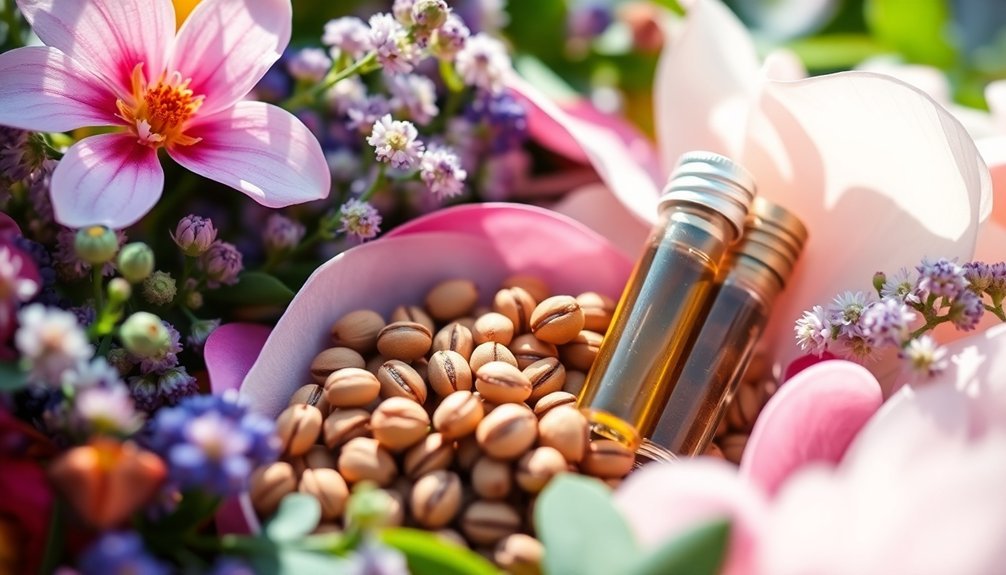
Ambrette seeds form the backbone of some of today's most sophisticated fragrances. You'll find these versatile seeds working harmoniously across various perfume families, from oriental to floral compositions.
For oriental and chypre fragrances, you can pair ambrette with patchouli and sandalwood to create warm, sensual bases.
In floral blends, it enhances delicate notes like rose, jasmine, and freesia, adding an elegant, feminine touch.
If you're crafting masculine scents, combine ambrette with woody accords like cedar and vetiver, or add whiskey and leather notes for a robust character.
For complex, layered perfumes, try mixing ambrette with vanilla, amber, or tonka bean.
It also works beautifully with iris and fig notes, creating sophisticated compositions that showcase ambrette's unique musky, powdery dimension.
Storage and Aging: Maximizing Potency
To maintain the exquisite qualities of your ambrette seed products, proper storage conditions play an essential role in preserving their potency and distinct aroma profile.
Store your bottles vertically in a cool, dark place away from direct sunlight and fluctuating temperatures. You'll want to use glass containers with tight-fitting stoppers, and keep them sealed to minimize air exposure.
- Refrigerate your ambrette products to slow oxidation, but avoid standard refrigerators with temperature fluctuations
- Dilute concentrated formulations with alcohol for long-term storage
- Check your collection regularly for signs of degradation or rancidity
Remember that proper storage can extend your products' shelf life up to 2-3 years.
When traveling, protect your bottles by wrapping them in soft fabric and storing them in sealed plastic bags. Always handle your containers with clean hands to prevent contamination from skin oils.
Common Mistakes When Using Ambrette Seeds
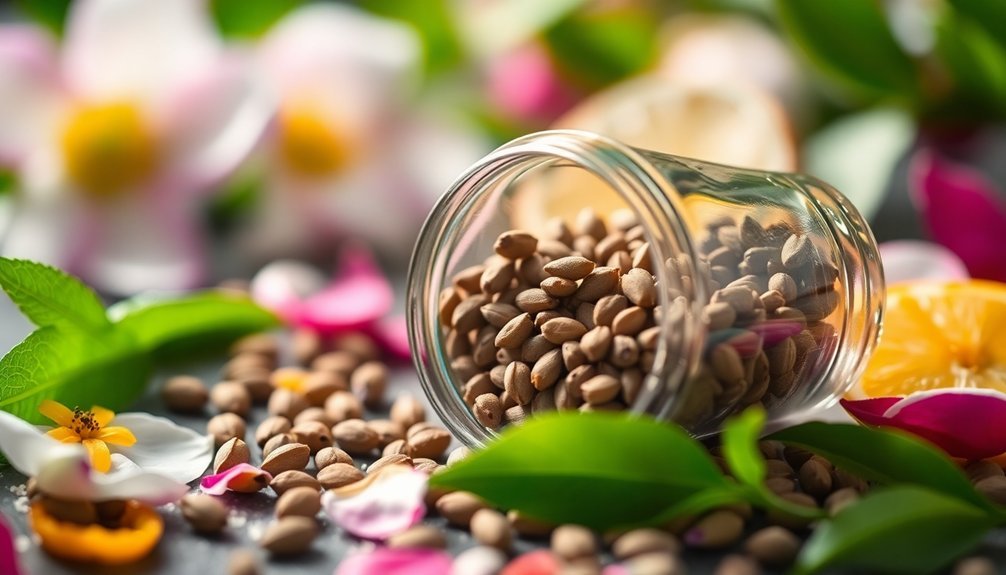
When crafting natural perfumes with ambrette seeds, even experienced perfumers can fall into common pitfalls that compromise their creations. You'll need to understand their unique scent profile and handle them with precision to avoid costly mistakes.
| Mistake Area | Common Error | Solution |
|---|---|---|
| Composition | Overpowering other notes | Use sparingly, balance with complementary scents |
| Storage | Exposure to humidity | Keep in airtight containers, control moisture |
| Sourcing | Using low-quality suppliers | Invest in verified sources despite higher costs |
| Processing | Improper extraction | Choose CO2 extraction for best results |
Don't confuse natural ambrette seeds with synthetic alternatives like Musk Ambrette, which is toxic and banned. Remember that the seeds' rich profile, including amber, wine, and fruity notes, requires careful blending with other ingredients like rose, neroli, and sandalwood to achieve the desired effect.
Essential Safety Guidelines for Natural Perfumers
Creating natural perfumes demands strict adherence to safety protocols that protect both perfumers and end users. Before incorporating any essential oils into your formulations, conduct patch tests on skin and monitor for reactions over 48 hours.
When working with ambrette seeds and other sensitive materials, store them in dark glass bottles in your refrigerator to prevent oxidation.
- Always dilute essential oils with proper carrier agents like perfumer's alcohol or fractionated coconut oil, aiming for an 80:20 carrier-to-fragrance ratio.
- Keep your workspace and materials away from vulnerable individuals, including children and those with health conditions.
- Stay informed about ingredient interactions, especially with citrus oils that increase sun sensitivity and restricted naturals like oakmoss.
Remember to comply with IFRA guidelines and maintain detailed records of your formulations for safety tracking.
Sustainable Sourcing and Quality Indicators
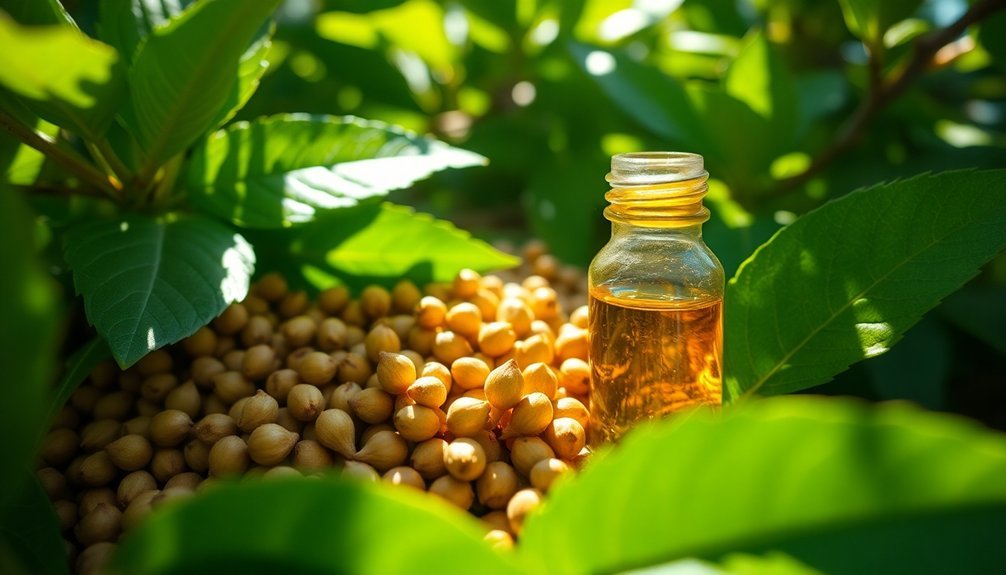
Since sustainability has become paramount in natural perfumery, responsible sourcing of ambrette seeds demands careful attention to both environmental and social impacts. You'll find these precious seeds cultivated in Guatemala, Peru, and Ecuador, where local communities partner with producers to maintain sustainable farming practices.
| Quality Indicator | What to Look For | Why It Matters |
|---|---|---|
| Traceability | Batch documentation | Guarantees ethical sourcing |
| Production Method | Natural processing | Preserves seed quality |
| Community Impact | Fair trade practices | Supports local farmers |
When selecting ambrette seeds for your natural perfumes, look for suppliers who maintain transparent relationships with farming communities and follow eco-conscious practices. Quality seeds come from producers who integrate crop rotation systems and employ careful harvesting techniques, guaranteeing both sustainability and ideal aromatic properties.
Creating Your Signature Base Accord
To craft a signature base accord with ambrette seeds, you'll need to understand how these precious ingredients interact with other foundational notes.
These versatile seeds serve as an excellent natural musk substitute, adding depth and sensuality to your base accord while working harmoniously with traditional base notes like sandalwood, cedarwood, and patchouli.
When creating your signature base, consider these essential combinations:
- Blend ambrette seeds with sandalwood for a rich, creamy foundation
- Pair with cedarwood to achieve a sophisticated woody character
- Combine with patchouli for an earthy, sensual depth
Remember to balance your proportions carefully, as the strength of each component will affect the overall character of your fragrance.
Your base accord will serve as the foundation that anchors your perfume's entire composition, providing lasting power and sophistication.
Frequently Asked Questions
Can People With Musk Allergies Safely Use Ambrette Seed-Based Perfumes?
While you're less likely to react to ambrette seeds since they're plant-based, not animal musk, it's still smart to do a patch test first. Everyone's sensitivities differ, so play it safe.
How Does Altitude Affect the Quality of Ambrette Seeds During Cultivation?
You'll find best ambrette seed quality at lower altitudes (below 1000-1650m) where temperatures remain ideal. While you can store seeds at higher elevations to protect from parasites, they won't grow well there.
What Causes Some Ambrette Seed Batches to Develop an Unpleasant Metallic Note?
You'll find metallic notes in ambrette seed batches when they're exposed to improper storage conditions, excessive heat during extraction, or oxidation from metal containers. Poor steam distillation techniques can also cause this issue.
Do Synthetic Preservatives Affect the Natural Fixing Properties of Ambrette Seeds?
Yes, synthetic preservatives can disrupt your ambrette seeds' natural fixing properties. They'll interact with the ambrettolide compound, potentially altering its chemical stability and reducing its ability to anchor other fragrance components effectively.
Why Do Ambrette Seeds From Different Regions Produce Varying Intensities of Animalic Notes?
You'll notice varying animalic intensities because soil composition, climate, and extraction methods in different regions affect the concentration of musk-like compounds, particularly ambrettolide, in your ambrette seeds' aromatic profile.
In Summary
You'll find ambrette seeds to be an invaluable ally in your natural perfumery journey. Their unique musk-like character and remarkable fixative properties can transform your blends from fleeting to long-lasting. Whether you're crafting delicate florals or rich orientals, these sustainable seeds will anchor your creations beautifully. Master their use, respect their potency, and you'll reveal endless possibilities in your natural perfume compositions.

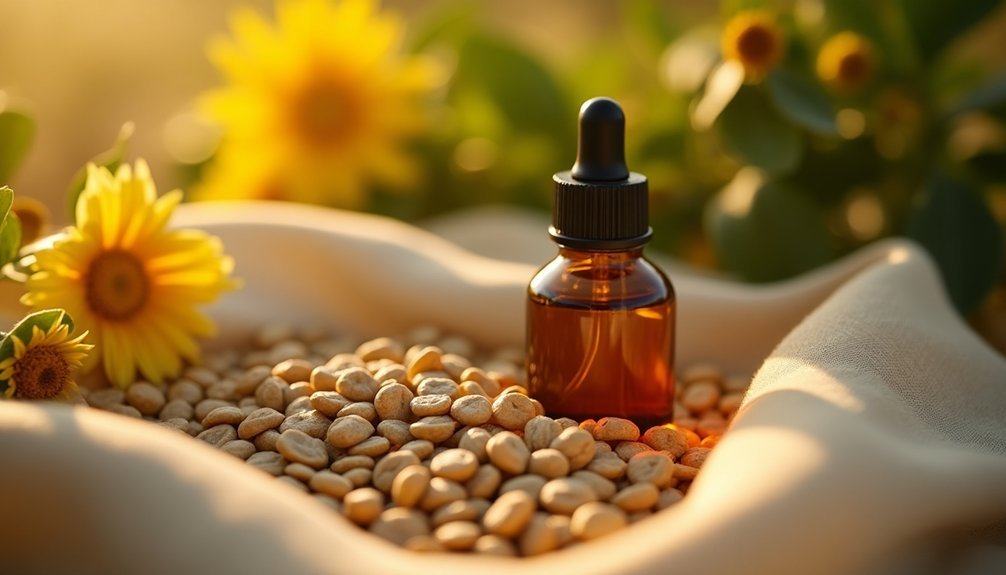
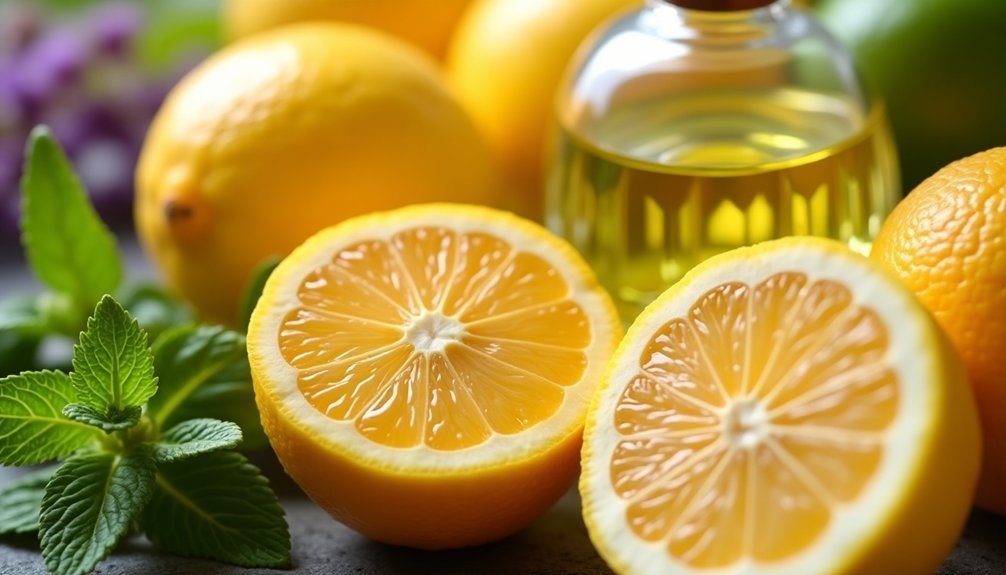
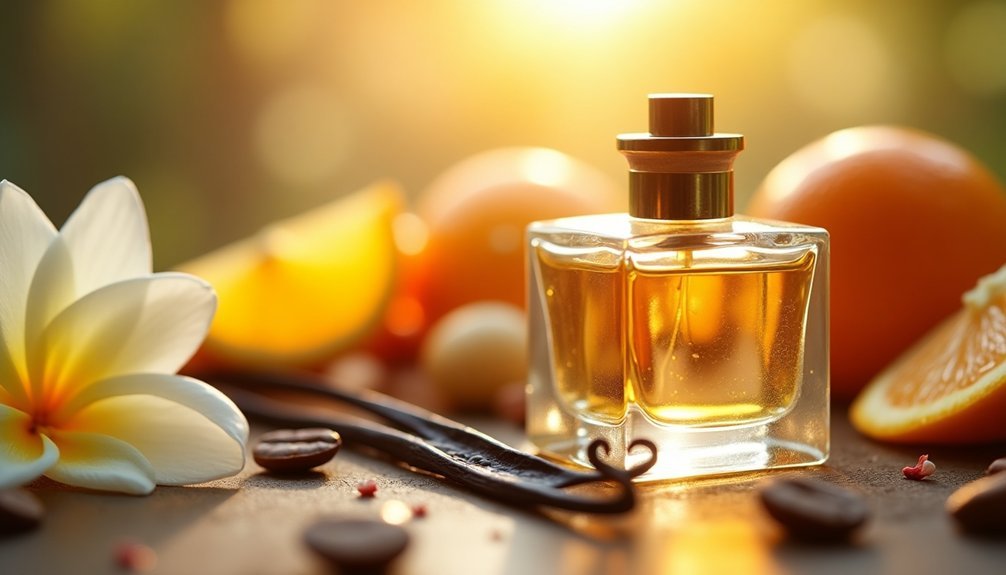

Leave a Reply